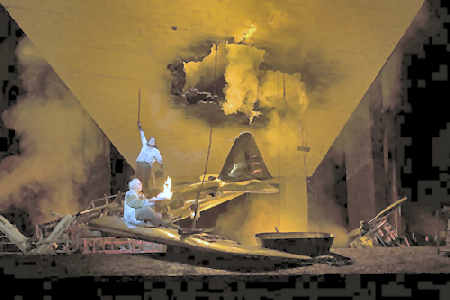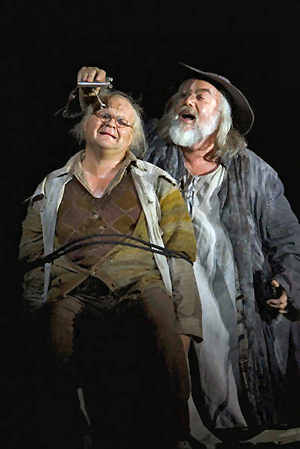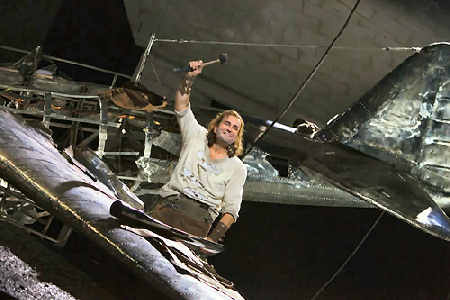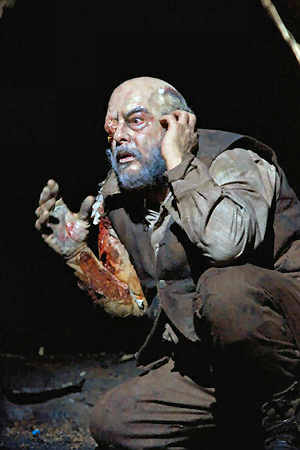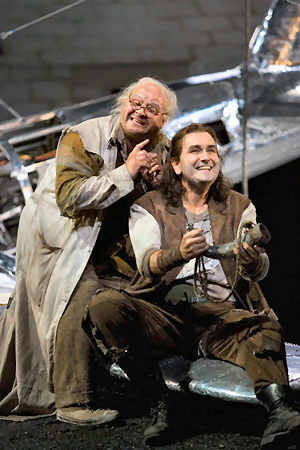|
Editor:
Marc Bridle
Webmaster: Len Mullenger
|
Seen and Heard Opera
Review
Well, after a very cluttered Das Rheingold and Die Walküre – either the money has run out or some much needed commonsense
has enlightened opera director Keith Warner to add some overdue
clarity to this Siegfried,
even though we are no where nearer understanding what he wants
us to get from his concept. If it is a post-apocalyptic Ring
– a post 9/11 one based on the skeletal remains of the fuselage
of a crashed plane that is a feature of Act I – then we have
seen it all better done before. (The ceiling has a hole through
which the plane came which is a bit too small and like that
of the Pentagon if we are to believe the conspiracy theorists
about that sad September day.) Surely the runway Siegfried
climbs up at the end of Act II is a slightly askew version
of Kupfer’s ‘Pathway to History’
at Bayreuth in the late 1980s? So we could be in a post-nuclear
bunker if the thought of that was not so passé as to make one believe
Warner has something else in mind.
During the opening to Act I there is a staging of
Siegfried’s development from a toddler in a pushchair to moody
adolescent capable of breaking Mime’s attempts at forging
him a sword. Mime’s spanking parental skills leave a lot to
be desired. Swirling images of mathematical formulae hint
at scientific knowledge lost, unappreciated or even abused.
Mime is well … Mime, shuffling and obsequious though artfully
sung by Gerhard Siegel. Siegfried’s bear is some deranged
individual in mask and muzzle, even possibly a genetic experiment
gone wrong and left to roam this underworld (there are further
echoes of this in the Act II Dragon). Siegfried enters looking
like almost the oldest teenager since Manfred Jung in the
Chéreau Centenary Ring at Bayreuth. (For some reason there
were several Adonis-like ‘heroes’ depicted in the programme
but that Treleaven certainly isn’t!) Singing conspicuously
flat and straining, it was not an auspicious start but he
did get better. He is scruffily clothed with cargo trousers
and Mime has a sort of tired laboratory technician look with
his attire also having seen better days (costumes are by Marie
Jeanne-Lecca).
With the Forging Scene things pick up a bit as John Treleaven (making his role début as that rare species, a British Siegfried) has harnessed his resources for this high spot and does not spoil it. He busies himself through one of the most active sword manufacturing processes seen for some time. He minces the metal, casts the weapon using a prop from the engine of the plane and there is lots of hammering – he also has time to crack an egg on Mime’s head as he cooks-up his plot to poison Siegfried. For ‘So schneidet Siegfrieds Schwert!’ he smashes the Aga/worksurface to a shower of sparks.
At
the start of Act II the pathway (in Stefanos Lazaridis’s
set) spirals into the distance
and there is atmospheric smoke effects and lighting (by Wolfgang
Göbbel).
Alberich carries an open wound as a result of being robbed
of the ring in Rheingold; that it has not closed makes
him seem rather like Amfortas were
Peter Sidholm not to look unnervingly similar to Keith Warner himself
and he bitterly confronts the Wanderer. A helix (again!) of
barbed wire protects Fafner’s cave,
or hole in the ground. Fafner guards his treasures with the
Rubik’s Cube Tarnhelm from before.
Siegfried and Mime enter and for Siegfried’s ‘Dass
der mein
Vater nicht ist’ (‘That he is not
my father’) we enter a Hansel
und Gretel dream world as the stage rises to find him
reclining on some grass on trolleys beneath a starry sky whilst
further gurneys bring on stuffed white male and female elks
… why you well may ask? The whittling of his reed pipe having
been standard stuff we now have Siegfried astride the male
deer and moved around the stage ‘chasing’ the Woodbird. She
is a pretty young singer (Sarah Fox) with a voice to match
costumed in pale combat fatigues and with a toy bird she flaps
then twirls around on the end of a fishing line. This ‘twirling’
is another Leitmotif of this production, chairs and the fuel
hose of the plane in Act I, this bird and a dead rat in Act
II.
Mime dons the head of a
rat as he unsuccessfully tries to deceive Siegfried and is
quickly dispatched. Fafner is the hideous head of that medical
procedure gone wrong alluded to before and would be quite
scary if the mechanics were smoother. Interesting stagecraft
finds the cone-shaped head of Fafner appear downstage under
the Tarnhelm and here Phillip Ens poignantly sings his last words ‘Acht
auf mich! Siegfried!’ (‘Pay heed
to me!’) There is nothing new again as the Woodbird demands
the attention of the gormless ‘boy’ to move him in the direction
he needs to go to find Brünnhilde - Siegfried gathers
up the cuboid Tarnhelm
and the Woodbird blows out the candle (lit earlier Tosca-like
for Mime and Fafner) at the very last note – distracting us
from the fact that after some reasonably pleasant lyrical
singing John Treleaven has made little of his last moments
and the start of his journey. As Act III begins there is no loss of dramatic continuity
because of the long break between acts II and III just as
in the previous Walküre there is none to lose between the first two acts … and then
the third. It comes from an entirely different – and better
– production. The rectangular white platform/wall reappears
from the previous opera against a dark cyclorama. It is said
if you take from one person it is theft but if you take from
everyone it is ‘research’. (I certainly know that unintentionally
I must on occasions in these reviews use a phrase I will have
over the years read elsewhere and filed away in my brain.
But what is Warner’s excuse?) We have the red lighting from
Chéreau,
the panorama from Jürgen Flimm’s
recent Bayreuth attempt, Götz Friedrich’s hydraulic platform
from Covent Garden in 1975 via Warner’s own use of it in his
Bayreuth Lohengrin, even the unseen revelation of ‘Das ist kein Mann!’ and
subsequent shadow-play was recently seen in Phyllida Lloyd’s,
now moribund, new Ring
cycle down the road at the London Coliseum. © Jim Pritchard Piictures: SIEGFRIED,
ROH – JOHN TOMLINSON AS WANDERER
(WOTAN), JOHN TRELEAVEN AS SIEGFRIED, GERHARD SIEGEL AS MIME,
PETER SIDHOM AS ALBERICH – PHOTOGRAPHER © CLIVE BARDA – OCT
2005 .
Back to the Top Back to the Index Page |
| ||
|
||||



